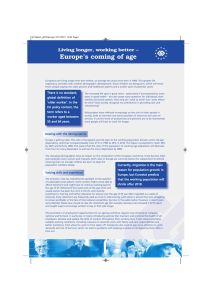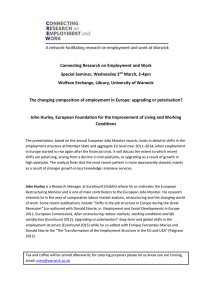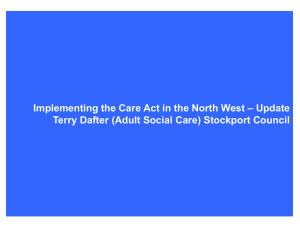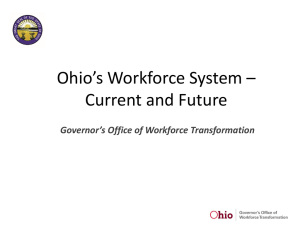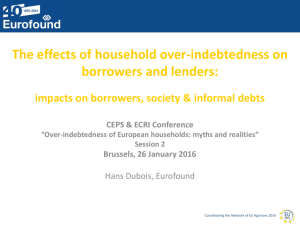Sustainable work over the life course: introduction
advertisement
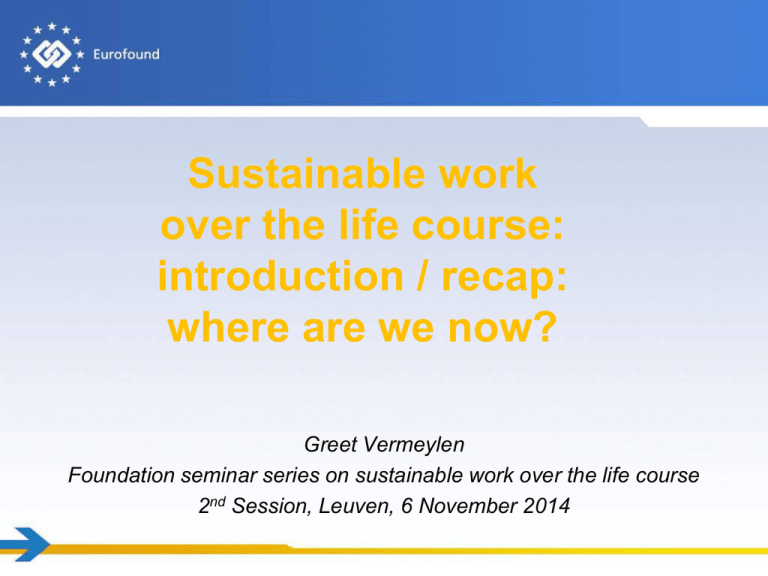
Sustainable work over the life course: introduction / recap: where are we now? Greet Vermeylen Foundation seminar series on sustainable work over the life course 2nd Session, Leuven, 6 November 2014 Do you think you will be able to do your current job when you are 60 years old? EU 27: 59% NL: 75% D = 72% ES: 49% FR: 46% SI: 26% (Eurofound, Fifth European Working Conditions Survey) Sustainable work? Factors which play a role (EWCS 2010) • Being willing and able to do the job until 60 Important determinants: • • • • • • • autonomy plays its protective role, work intensity is a deterrent Karasek is important (job strain - / active jobs +) work-life balance Incl. working time autonomy cognitive dimensions of work involvement in workplace organisation/innovation social support from colleagues and managers But also important: intrinsic rewards violence and harassment, exposure to ergonomic risks, job insecurity associated with lower levels of job sustainability Eurofound’s project Aim: to identify the main dimensions of sustainable work throughout the life course and to develop a Eurofound concept • A number of activities are being carried out: Literature reviews, considering three strands of research: - Impact of working conditions over the life course - Sustainable work systems - Life course perspective (incl. gender) Seminar with stakeholders in November 2013 Foundation seminar series (1st session May & 2nd session Nov) Concept paper National case studies + series of projects on specific issues Advisory Committee for discussion in the October meeting. A final paper will be sent for written evaluation Sustainable work over the life course • Tackling demographic change: more people at work for longer? Sustainable work over the life course refers to conditions that: - attract more people into the labour market - ensure that people work in such a way that they do not compromise their future ability to work and live in a satisfactory manner Requires a dynamic and integrated approach to job quality - impact of particular working conditions on the well-being and employability of workers can significantly vary in short and long term - through the work trajectory over the life course Depends on other aspects of the workers´ lives, beyond work itself, throughout the life course Is influenced by social policies external to the work sphere Employment and social protection systems and social infrastructure. • Attract more people to the workforce: make it possible for more people to work, (i.e. time, health & skills) • Ensure that people can (and want to) stay longer in the workforce, consider both quality of work and the working environment 6 Sustainable work: Eurofound concept CURRENT WORKFORCE High paid good jobs longer JOB QUALITY Earnings Prospects Intrinsic job quality Working time quality Poorly balanced jobs characteristics of the job Well balanced good jobs Low quality jobs Policies, regulations, practices and actions on Job quality in general Sub-dimensions like occupational health and safety (OSH), working time, human resources, remuneration… Sustainable work: Eurofound concept CURRENT WORKFORCE Time availability/care obligations Life events and life course policies / care infrastructure Health / well being Skills / employability characteristics Unemployment/inactivity of the worker Motivation Potential workforce LIFE COURSE ISSUES Inclusion of people with reduced physical and mental health capacity / health promotion Lifelong learning policies / Learning organisations Active labour market policies / life long guidance / job matching Meaningful work / the functions of work itself Sustainable work: Eurofound concept POLICIES, REGULATION, PRACTICES… Public policies CURRENT WORKFORCE LIFE COURSE LIFE COURSE ISSUES Time availability/care obligations potential workforce Companies Job quality in general (job design, organisation, limit exposure, deal with consequences) Sub-dimensions of job quality: Remuneration Prospects (progression, security…) Intrinsic job quality : physical (health and safety) and Social environment (support) , skills and autonomy, work intensity, Working time JOB QUALITY characteristics of the job characteristics of the worker Social partners Life events and lifecourse policies / care infrastructure Health / well being Inclusion policies: people with reduced physical and mental health capacity / health promotion Skills / employability Lifelong learning, skills development Unemployment / inactivity Active labour market policies / lifelong guidance / job matching Motivation Meaningful work / the functions of work itself Outlook • Understanding working over the life course is complicated. • Making working life longer implies rethinking of the place of work in our societies. • Different ways to achieve this objective can be identified. Consequences of certain (combinations of) working conditions • New career paths in a volatile environment a cumulative effect of some working conditions (+ work intensification) longer or shorter impact, permanent or temporary scar impact needs to be assessed over the life course and considering the work trajectory of the worker. complemented with the impact of individual factors (related directly to the worker and his or her private life) on the working capacity over the life course. Outlook ctd • A wide range of actors are involved at different levels Policies aimed at directly or indirectly increasing working life duration with particular focus on job quality, OSH, working time, gender equality, welfare & employment systems, company practices, collective agreements Unintended consequences of certain policies Policies can be addressed to all or some workers Combinations of policies and practices … sustainability proofing More research to understand interaction between different aspects of work as well as between work and private life, scarring and/or lasting effects of certain working conditions • Not a ‘one fits all’ solution All countries have a mix of policies, systems and company practices which are related to /might lead to sustainable work over the life course for all. Thank you 12
